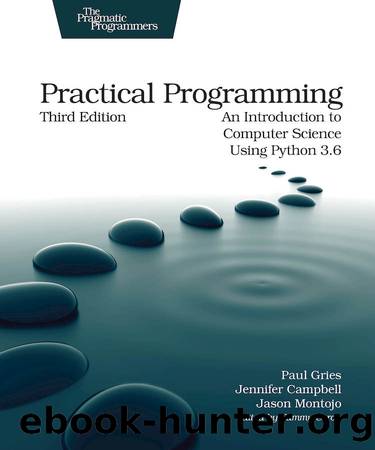Practical Programming: An Introduction to Computer Science Using Python 3.6 by Paul Gries & Jennifer Campbell & Jason Montojo

Author:Paul Gries & Jennifer Campbell & Jason Montojo [Gries, Paul]
Language: eng
Format: azw3
Tags: Pragmatic Bookshelf
Publisher: Pragmatic Bookshelf
Published: 2017-12-05T16:00:00+00:00
Writing Algorithms That Use the File-Reading Techniques
There are several common ways to organize information in files. The rest of this chapter will show how to apply the various file-reading techniques to these situations and how to develop some algorithms to help with this.
Skipping the Header
Many data files begin with a header. As described in The Readline Technique, TSDL files begin with a one-line description followed by comments in lines beginning with a #, and the Readline technique can be used to skip that header. The technique ends when we read the first real piece of data, which will be the first line after the description that doesn’t start with a #.
In English, we might try this algorithm to process this kind of a file:
Skip the first line in the file
Skip over the comment lines in the file
For each of the remaining lines in the file:
Process the data on that line
The problem with this approach is that we can’t tell whether a line is a comment line until we’ve read it, but we can read a line from a file only once—there’s no simple way to “back up” in the file. An alternative approach is to read the line, skip it if it’s a comment, and process it if it’s not. Once we’ve processed the first line of data, we process the remaining lines:
Skip the first line in the file
Find and process the first line of data in the file
For each of the remaining lines:
Process the data on that line
The thing to notice about this algorithm is that it processes lines in two places: once when it finds the first “interesting” line in the file and once when it handles all of the following lines:
from typing import TextIO
from io import StringIO
def skip_header(reader: TextIO) -> str:
"""Skip the header in reader and return the first real piece of data.
>>> infile = StringIO('Example\\n# Comment\\n# Comment\\nData line\\n')
>>> skip_header(infile)
'Data line\\n'
"""
# Read the description line
line = reader.readline()
# Find the first non-comment line
line = reader.readline()
while line.startswith('#'):
line = reader.readline()
# Now line contains the first real piece of data
return line
def process_file(reader: TextIO) -> None:
"""Read and print the data from reader, which must start with a single
description line, then a sequence of lines beginning with '#', then a
sequence of data.
>>> infile = StringIO('Example\\n# Comment\\nLine 1\\nLine 2\\n')
>>> process_file(infile)
Line 1
Line 2
"""
# Find and print the first piece of data
line = skip_header(reader).strip()
print(line)
# Read the rest of the data
for line in reader:
line = line.strip()
print(line)
if __name__ == '__main__':
with open('hopedale.txt', 'r') as input_file:
process_file(input_file)
In skip_header, we return the first line of read data, because once we’ve found it, we can’t read it again (we can go forward but not backward). We’ll want to use skip_header in all of the file-processing functions in this section.
Download
This site does not store any files on its server. We only index and link to content provided by other sites. Please contact the content providers to delete copyright contents if any and email us, we'll remove relevant links or contents immediately.
| Coding Theory | Localization |
| Logic | Object-Oriented Design |
| Performance Optimization | Quality Control |
| Reengineering | Robohelp |
| Software Development | Software Reuse |
| Structured Design | Testing |
| Tools | UML |
Deep Learning with Python by François Chollet(12555)
Hello! Python by Anthony Briggs(9904)
OCA Java SE 8 Programmer I Certification Guide by Mala Gupta(9785)
The Mikado Method by Ola Ellnestam Daniel Brolund(9769)
Dependency Injection in .NET by Mark Seemann(9329)
Algorithms of the Intelligent Web by Haralambos Marmanis;Dmitry Babenko(8282)
Test-Driven iOS Development with Swift 4 by Dominik Hauser(7756)
Grails in Action by Glen Smith Peter Ledbrook(7686)
The Well-Grounded Java Developer by Benjamin J. Evans Martijn Verburg(7550)
Becoming a Dynamics 365 Finance and Supply Chain Solution Architect by Brent Dawson(7007)
Microservices with Go by Alexander Shuiskov(6774)
Practical Design Patterns for Java Developers by Miroslav Wengner(6684)
Test Automation Engineering Handbook by Manikandan Sambamurthy(6629)
Secrets of the JavaScript Ninja by John Resig Bear Bibeault(6399)
Angular Projects - Third Edition by Aristeidis Bampakos(6035)
The Art of Crafting User Stories by The Art of Crafting User Stories(5566)
NetSuite for Consultants - Second Edition by Peter Ries(5497)
Demystifying Cryptography with OpenSSL 3.0 by Alexei Khlebnikov(5302)
Kotlin in Action by Dmitry Jemerov(5048)
